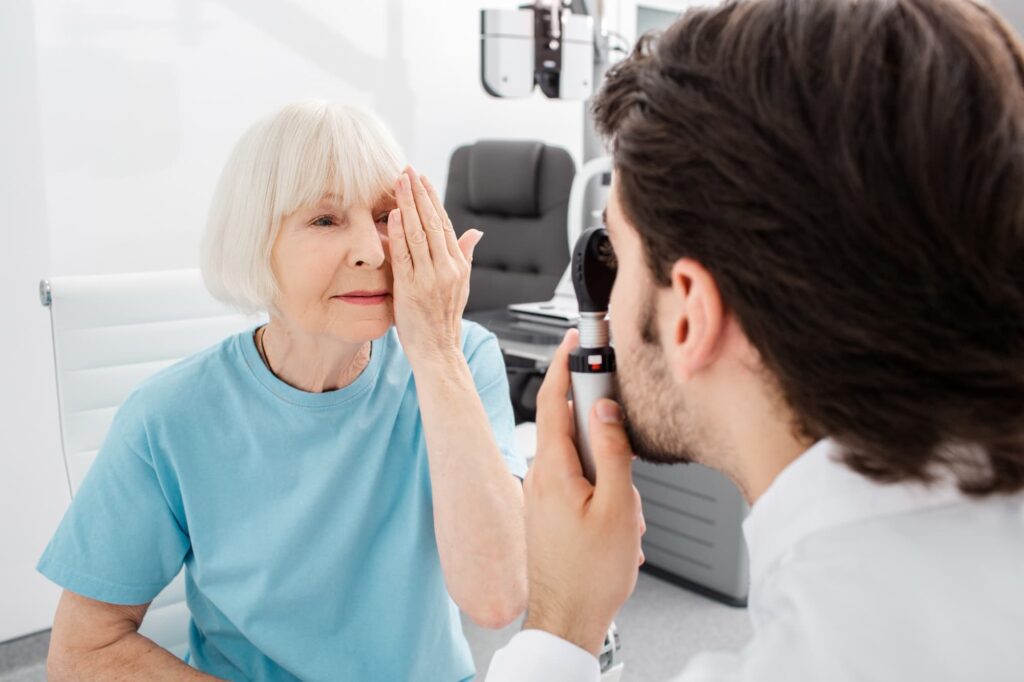
After reading our blog post on the symptoms of a cataract, you’ll learn:
- What a cataract is and what causes them to form
- What the symptoms of a cataract are and when you should see a doctor about them
- Where you can receive high-quality, state-of-the-art eye care from Louisiana’s leading cataracts experts
The National Institute of Health projects that by 2050 the number of Americans with at least one cataract will grow to nearly 50 million people. For context, that’s more than twice the number of people diagnosed with a cataract in 2010.
Since cataracts will become more common, it’s important to have some basic understanding about the potential issue you or someone in your family may face in the upcoming years. Among that new knowledge should be the symptoms of cataracts. This information will help you understand when you or a family should seek medical testing to confirm the diagnosis and what treatment options could be available to you.
What Is a Cataract?
Your eye is a complex component of your body, and just like with the rest of your body, as you begin to age, the various parts of the eye can begin to show the signs of aging by the loss of clear vision. The lens of your eye, which acts similarly to a camera lens, focuses incoming light at the back of your eye. This part of your eye is called the retina, and it’s where your eye processes images. When everything is working properly, you should have crystal clear vision.
When the lens becomes cloudy, though, it becomes harder to see. It can feel like you’re looking through a waterfall or dirty glass. That clouded lens is what doctors call a cataract.
There are multiple types of cataracts to be aware of:
- Congenital cataracts
- Cortical cataracts
- Nuclear cataracts
- Posterior subcapsular cataracts
Each type of cataract may offer slightly different symptoms. You could even have a cataract and experience no symptoms whatsoever until there’s a sudden change in your ability to see. Therefore it’s important to see your eye doctor regularly.
What Causes Cataracts?
Some people are born with cataracts. Some may get a cataract due to a particular injury to their eye. However, most people tend to develop a cataract as they grow older.
Beyond age, genetics, and injury, a variety of risk factors also play a role in the growth of a cataract:
- Diabetes
- Elevated blood pressure
- Excessive alcohol consumption
- Excessive sunlight exposure
- Extended use of corticosteroids
- Obesity
- Previous eye surgery
- Smoking
There is no scientifically proven way to prevent the development of cataracts. Based on the listed risk factors, though, you may be able to take steps and reduce your odds:
- Stop smoking
- Eat a healthy diet full of antioxidants
- Receive regular eye examinations
- Reduce your consumption of alcohol
- Treat any lingering health issues
- Wear protective sunglasses while outside
Again, taking these steps does not assure you a cataract-free life, especially as you age. However, improving your overall health may slow down its progression.
What Are the Symptoms?
Knowing all of the common signs of cataract development can help identify when you need to make an appointment with your eye provider for a proper diagnosis. If you have a cataract, you may not experience all of these symptoms, but even a single symptom should lead you to make an appointment with your eye doctor for a full evaluation.
Blurred Vision
A cataract occurs when the lens of your eye becomes cloudy. So, it makes sense that one of the most common signs of cataract development is blurred vision. This symptom can start off not being too much of an issue, but, over time it will often lead to a much more significant issue down the road.
People with cataracts often describe their vision as blurry, cloudy, or dim. So, if it feels like all of the sudden you’re looking through clouded glass all the time, you may be dealing with a cataract.
Difficulty Seeing at Night
The lens of your eye is designed to let in light. As the lens becomes cloudy, less light passes through and makes its way towards the back of your eye, where images are processed. So, it makes sense that another common symptom of a cataract is difficulty seeing at night when light is not plentiful.
This often causes issues with driving, as it becomes hard to read street signs or what’s in front of you on the road. So, undiagnosed or untreated cataracts could become an issue of public safety for you and other people driving.
Dimmed or Yellowed Colors
Not only does a cataract cloud your lens, but it also turns the proteins inside a brownish-yellow color. This gives everything you see a dimmed or yellowish tint to it. Simply put, a cataract makes the world around you seem dull and less colorful. When this happens, you may even have trouble noticing the difference between certain colors.
Double Vision
Double vision is another common symptom of cataracts. As the lens of your eye becomes cloudier, it loses its ability to focus incoming light into a tight beam that reaches the back of your eye. Instead, it often ends up refracting the incoming light. The result is you end up seeing double.
Of course, double vision is also the symptom of any number of health concerns. If you find yourself seeing double, it’s important to see an eye care specialist right away.
Frequent Glasses or Contact Lens Prescription Changes
As cataracts grow, your vision will become worse. That’s because the lens of your eye may be getting cloudier at an accelerated rate even if the initial effect was minimal. As your vision becomes increasingly worse, you’ll notice a more frequent need to update the prescription on your eyeglasses or contact lenses.
As you get these prescription updates, you should have an eye doctor examine your eyes. A small cataract that may not have been causing much of an issue could now be much more significant in size and scale.
Light or Glare Sensitivity
While light and glare sensitivity are often associated with cataracts, those with posterior subcapsular cataracts may experience an even more heightened effect. That is, intense lights or glare can become physically painful to the point where it’s unbearable.
Seeing Halos Around Lights
The final symptom of a cataract is the presence of halos around lights, especially at night. The halos are caused by the clouded lens refracting light differently through your eye, which creates a ring effect around every light. Halos around headlights and streetlights are especially pronounced.
Talk to a Cataract Surgeon in Louisiana at WK Eye Institute
If you’re experiencing any of the symptoms listed above, it’s time to call The Cataract Surgeons to have your eyes tested. As one of the leading eye-care institutes in the United States, we’ve helped people from all over the country at our multiple eye care centers in Louisiana.
Our team can help assess your eyes’ issues and partner with you to develop treatment options that work with your needs and budget. Request an appointment today so that we can get you back on the path towards better eyesight.
Featured Image: Peakstock/Shutterstock



